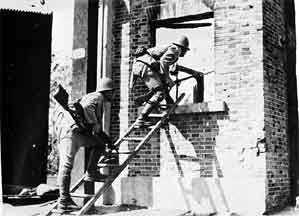1932 Japanese Attack Shanghai
The Japanese continued their assault on China by attacking Shanghai. The Western powers protested vigorously and sent reinforcements to defend their interests. Heavy Western pressure forced the Japanese to withdraw..
On January 18, 1932, a Japanese Buddhist monk was found dead near a train station in Shanghai. Japan accused Chinese nationalists of the murder and used it as a pretext to increase its military presence in the city. On January 28, after failing to reach an agreement with the Chinese authorities, the Japanese forces attacked the city of Shanghai.
The battle was fierce and lasted over a month, with both sides suffering heavy casualties. The Chinese forces, led by Generalissimo Chiang Kai-shek, were determined to defend their territory and prevent further Japanese expansion. The fighting was concentrated in the Zhabei, Jiangwan, and Hongkou districts, and the Chinese forces initially managed to hold their ground.
International Involvement: The international community, particularly the Western powers, was alarmed by the escalating conflict in Shanghai. The city was a hub for international trade and investment, and many foreign nations had established concessions in the city. To protect their interests, several nations, including the United States, the United Kingdom, and France, sent naval forces to the area.
Resolution and Aftermath: On February 29, 1932, a ceasefire agreement was reached under the mediation of the League of Nations, and hostilities ceased on March 3. Both sides agreed to withdraw their troops from Shanghai, and an international demilitarized buffer zone was established around the city.
Although the January 28 Incident did not result in a decisive victory for either side, it exposed the weakness of the Chinese military and further fueled Japanese expansionist ambitions in East Asia. The conflict also highlighted the inability of the League of Nations to effectively intervene in regional disputes. The tensions between China and Japan continued to simmer, ultimately culminating in the full-scale Second Sino-Japanese War in 1937.
 >
>